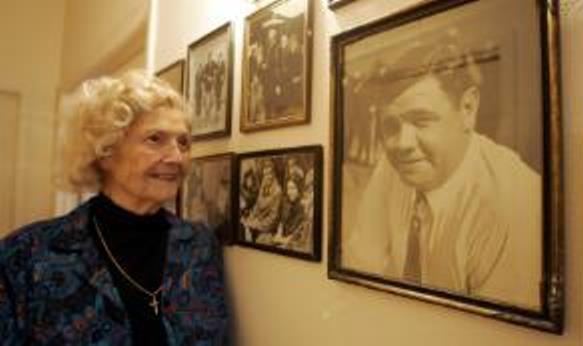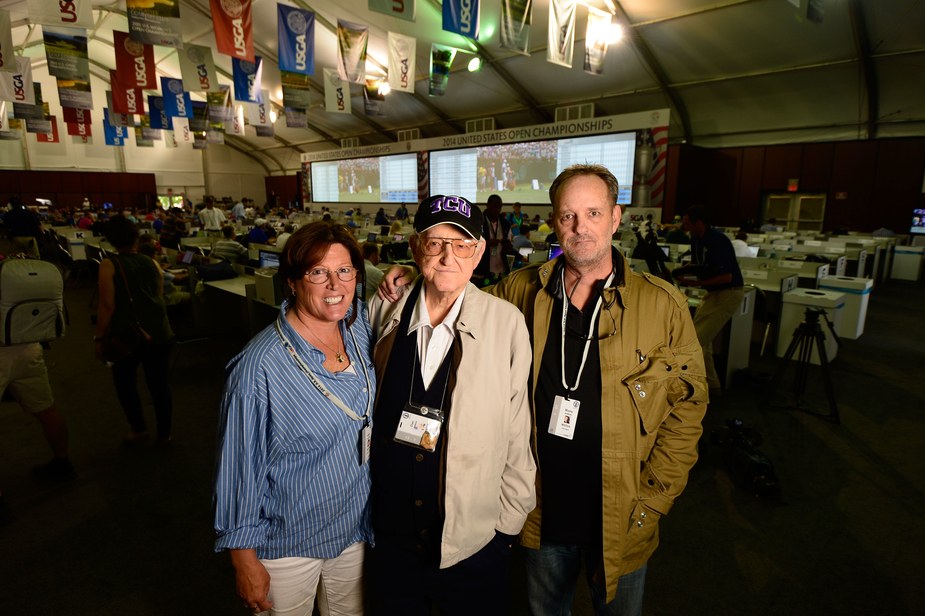|
Two daughters who adored their fathers.
Julia Ruth Stevens died Saturday at 102. She was the adopted daughter of Babe Ruth and, as long as she lived, referred to him as “Daddy,” as Richard Goldstein notes in his masterful obituary. Dan Jenkins, one of greatest sportswriters, died Thursday at 90. He was eulogized by many admirers in his business, the best coming from, of course, his daughter, Sally Jenkins, sports columnist at the Washington Post. Sally, terrific writer that she is, described the hectic and eccentric life of a sports columnist who was usually at a golf tournament or football game when the family gathered for Thanksgiving and other holidays. . Her dad was as glib about the indignities of old age as he was about golfers who mis-read the terrain of the course. Sally tells about her dad wheeling himself down the hallway of the hospital heading toward a presumed quadruple heart bypass. When he emerged, he was told he had needed only a triple. "I birdied the bypass," he pronounced. That’s it. I’m not going to try to duplicate the Jenkins family, father or daughter. Read Sally’s tribute to her dad. The Washington Post has a pretty strong paywall, bless its heart, but you might be able to read it there, or the Chicago Tribune. Or pay for it. https://www.washingtonpost.com/ https://www.chicagotribune.com/sports/ct-spt-sally-jenkins-remembers-father-dan-jenkins-20190309-story.html Plus, Bruce Weber’s excellent obit in the NYT: https://www.nytimes.com/2019/03/08/obituaries/dan-jenkins-dead.html Babe Ruth’s daughter also receives a brilliant tribute in the Monday NYT. She was the daughter of Babe’s wife, Clare Hodgson, and was adopted and treated royally, as a daughter by the gregarious, larger-than-life Babe. No doubt she witnessed, and heard about, examples of Babe’s excesses, even after he stopped playing. As subtle as a diplomat, she discussed “Daddy” as she saw him – a man who made egg-and-salami sandwiches and took her golfing out in Queens. And when she started dating, he insisted she be home by midnight. Imagine: The Babe. Enforcing a curfew. They lived on the Upper West Side, in a 14-room apartment; whenever I am in that neighborhood I envision The Babe, with a cap on his head, walking on Riverside Drive or thereabouts, just another West Side burgher. She was an ambassador not only for “Daddy” but for baseball itself, waving to adoring crowds at the closing of “The House That Ruth Built,” waving to adoring crowds at Fenway Park, where The Babe first pitched shutouts and hit home runs. When my alma mater, Hofstra University, held an academic conference on The Babe in 1995, she and her son, Tom Stevens, represented the Babe and gave out Babe Ruth bats to a few lucky people, including me. https://lwww.nytimes.com/1995/05/01/sports/sports-of-the-times-the-babe-redbirds-and-a-sunday-game.html But that’s enough from me. Better you should read Richard Goldstein’s obituary of Mrs. Stevens: https://www.nytimes.com/2019/03/09/obituaries/julia-ruth-stevens-dead-babe-ruth.html
Josh Rubin
3/11/2019 01:31:34 pm
I enjoyed the piece, George.
George Vecsey
3/12/2019 08:47:37 am
Josh: quite right. Page 38 of "We Are Staying," Jen Rubin's book about the family electronics store, Radio Clinic, on the Upper West Side, she writes: "My grandfather's favorite celebrity customer was Babe Ruth."
Jeff Geller
3/11/2019 07:37:28 pm
Hello George, I almost choke on my hoagie sandwich when I read Sally Jenkins describing her dad*s last manuscript; invoking the names of the main character*s dogs. From what I learned about him is that he did not believe in diplomatic prose,
George Vecsey
3/12/2019 08:55:17 am
Jeff: Tom and Giselle? Names strike a familiar chord.
Altenir Silva
3/11/2019 09:19:27 pm
Dear George: It's a touching tribute to the Babe's daughter and Dan Jenkins as well.
George Vecsey
3/12/2019 08:56:19 am
Altenir, good to hear from you. I thought I might hear from you at the end of Carnival....best, GV
Altenir Silva
3/16/2019 10:13:36 am
Dear George,
bruce
3/12/2019 09:48:26 am
george,
bruce
3/12/2019 11:36:45 am
george,
bruce
3/16/2019 11:24:08 am
altenir,
Altenir Silva
3/16/2019 01:55:35 pm
Dear Bruce,
altenir,
3/16/2019 01:58:24 pm
altenir, Comments are closed.
|
Categories
All
|











